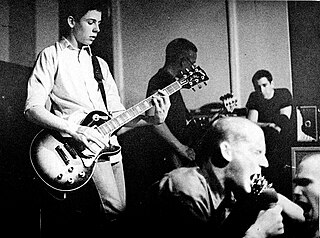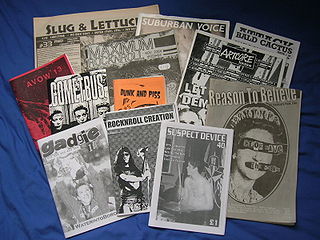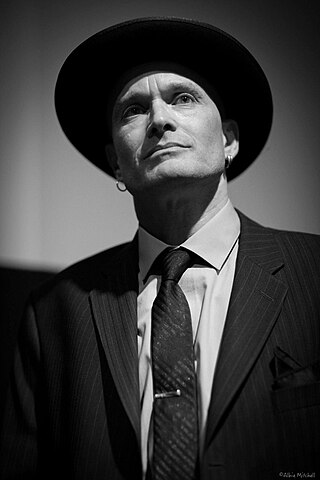
Minor Threat was an American hardcore punk band, formed in 1980 in Washington, D.C., by vocalist Ian MacKaye and drummer Jeff Nelson. MacKaye and Nelson had played in several other bands together, and recruited bassist Brian Baker and guitarist Lyle Preslar to form Minor Threat. They added a fifth member, Steve Hansgen, in 1982, playing bass, while Baker switched to second guitar.
No wave was an avant-garde music genre and visual art scene which emerged in the late 1970s in Downtown New York City. The term was a pun based on the rejection of commercial new wave music. Reacting against punk rock's recycling of rock and roll clichés, no wave musicians instead experimented with noise, dissonance, and atonality, as well as non-rock genres like free jazz, funk, and disco. The scene often reflected an abrasive, confrontational, and nihilistic world view.

In the arts and in literature, the term avant-garde identifies a genre of art, an experimental work of art, and the experimental artist who created the work of art, which usually is aesthetically innovative, whilst initially being ideologically unacceptable to the artistic establishment of the time. The military metaphor of an advance guard identifies the artists and writers whose innovations in style, form, and subject-matter challenge the artistic and aesthetic validity of the established forms of art and the literary traditions of their time; thus how the artists who created the anti-novel and Surrealism were ahead of their times.
SSD was a straight edge hardcore band from Boston. They released two records as SS Decontrol and then formally changed their name to SSD. As SSD they released two more records with a heavy metal influenced sound. However, the group is often simply referred to, including all its periods, as SSD.
DYS is an American straight edge hardcore punk band from Boston, Massachusetts, who were part of the "Boston Crew" in the 1980s, along with contemporaries such as SSD and Negative FX. The group later expanded their sound, becoming one of the first hardcore bands to veer into heavy metal.
The F.U.'s are a hardcore punk band from Boston, Massachusetts. They formed in 1981 as a three-piece band, released three records and appeared on the compilation This Is Boston, Not L.A. before changing their name to Straw Dogs in 1986 to market themselves as a heavy metal act. In 2010 The F.U.'s reformed under their original moniker.

ABC No Rio is a collectively-run non-profit arts organization on New York City's Lower East Side. It was founded in 1980 in a squat at 156 Rivington Street, following the eviction of the 1979-80 Real Estate Show. The centre featured an art gallery space, a zine library, a darkroom, a silkscreening studio, and public computer lab. In addition, it played host to a number of radical projects including weekly hardcore punk matinees and the city Food Not Bombs collective.

Punk visual art is artwork associated with the punk subculture and the No wave movement. It is prevalent in punk rock album covers, flyers for punk concerts and punk zines, but has also been prolific in other mediums, such as the visual arts, the performing arts, literature and cinema. Punk manifested itself "differently but consistently" in different cultural spheres. Punk also led to the birth of several movements: new wave, no wave, dark wave, industrial, hardcore, queercore, etc., which are sometimes showcased in art galleries and exhibition spaces. The punk aesthetic was a dominant strand from 1982 to 1986 in the many art galleries of the East Village of Manhattan.
Jonathan Anastas is an American, Los Angeles–based marketing and advertising executive, and a musician who co-founded a number of Boston hardcore punk bands.
More Fire! Productions was a women's theatre collective active in New York City from 1980 to 1988. It was founded by Robin Epstein and Dorothy Cantwell and based in the East Village section of Lower Manhattan, New York City. More Fire! Productions created and produced eight full-length plays between 1980 and 1988, becoming known as "one of the city's leading women's theatre groups" for its contributions to the downtown, experimental theatre, and women's and lesbian theatre scenes of the 1980s. Epstein and Cantwell co-wrote, produced, and performed in the company's first three plays: As the Burger Broils (1980), The Exorcism of Cheryl (1981), and Junk Love (1981), which had numerous runs and became a neighborhood cult classic, "the longest running show on Avenue A." Epstein then wrote and produced The Godmother (1983). Novelist and writer Sarah Schulman joined the company in 1983 and collaborated on the writing and performing of three later plays: Art Failures (1983), Whining and Dining (1984), and Epstein on the Beach (1985). The final play, Beyond Bedlam (1987), was written and produced by Epstein, who was the only person involved in all More Fire! plays.
Noise Fest was an influential festival of no wave noise music performances curated by Thurston Moore of Sonic Youth at the New York City art space White Columns in June 1981. Sonic Youth made their first live appearances at this show.
The Marinko Sudac Collection, based in Zagreb, Croatia, has been created with a clear collecting strategy based on the region of Central and Eastern Europe, additionally spanning from the Baltic area to the Black Sea. The guiding principle of the Collection is systematic exploration, researching, and promotion of the avant-garde practices which have been marginalized, forbidden, and at times completely negated due to the historical, social and political circumstances. In this context, the Marinko Sudac Collection gives the most complete and comprehensive overview on the art of this region. The Collection starts at 1909, and it show the continuity from the first Avant-Gardes, through neo-avant-garde and New Artistic Practices, ending with the fall of the Berlin Wall. The global uniqueness of the Marinko Sudac Collection is also seen in the kind of media it contains. It contains not only traditional artworks, such as paintings, sculptures, and photographs, but it gives equal importance to documentary and archival material. Great importance is put on these almost forgotten media, which enable research of specific phenomena, artists and the socio-political situation which affected this type of art. The Collection contains a great number of museological units, and it treats the documentary and archival material on the same level as traditional artworks. By examining the units contained in the Marinko Sudac Collection, one can read not only the art scene or the art production of a certain artist, but the full status of the society, the socio-political atmosphere of the region in which this art was created in.
April Palmieri is an American photographer and musician who performed with a 12-piece all-woman percussion band, Pulsallama. During the early 1980s, the band played at such venues as the Mudd Club, the Pyramid, Danceteria, and Club 57 in New York's East Village. Palmieri's photography from this era, including of Keith Haring and John Sex, has been included in an exhibition at the Tate Liverpool and an exhibition at the Museum of Modern Art (MoMA).
Julien Levy (1906–1981) was an art dealer and owner of Julien Levy Gallery in New York City, important as a venue for Surrealists, avant-garde artists, and American photographers in the 1930s and 1940s.

All Ages: The Boston Hardcore Film, a Gallery East Production in association with Stone Films/NYC, is a documentary directed by Drew Stone, which had its world premier at the Independent Film Festival of Boston on April 27, 2012. The film features interviews, archival footage and the music of Boston’s early hardcore bands including Deep Wound, DYS, Gang Green, Impact Unit, Jerry's Kids, Negative FX, SS Decontrol, The Freeze and The F.U.'s. Also featured in the film are interviews with renowned author Michael Patrick MacDonald, Actress Christine Elise McCarthy, Advertising Executive Jonathan Anastas, Thrasher Magazine Editor Jake Phelps, "American Hardcore" Director Paul Rachman, "Blowing Smoke with Twisted Rico Podcast" host Steev Riccardo, and Newbury Comics owner Michael Dreese. All Ages has been released on DVD with numerous extras and director's commentary.

Drew Stone is an American film director, producer, film editor, author and musician. His works include music videos, commercials, documentary films and television.
James Allan Curtis, known professionally as Diego Cortez, was an American filmmaker and art curator closely associated with the no wave period in New York City. Cortez was the co-founder of the Mudd Club, and he curated the influential post-punk art show New York/New Wave, which brought the then aspiring artist Jean-Michel Basquiat to fame.
The Boris Mirski Gallery (1944–1979) was a Boston art gallery owned by Boris Chaim Mirski (1898–1974). The gallery was known for exhibiting key figures in Boston Expressionism, New York and international modern art styles and non-western art. For years, the gallery dominated with both figurative and African work. As an art dealer, Mirski was known for supporting young, emerging artists, including many Jewish-Americans, as well as artists of color, women artists and immigrants. As a result of Mirski's avant-garde approach to art and diversified approach to dealing art, the gallery was at the center of Boston's burgeoning modern mid-century art scene, as well as instrumental in the birth and development of Boston Expressionism, the most significant branch of American Figurative Expressionism.
Nye Ffarrabas, is an American artist and poet known for her contributions to the first generation of Fluxus. She participated in Judson Gallery shows at Judson Memorial Church in 1966-1968.